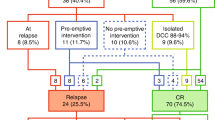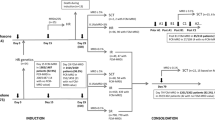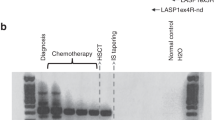Summary:
The clinical utility of minimal residual disease (MRD) measurements following allogeneic stem cell transplantation (SCT) in childhood ALL is controversial. We therefore performed a multi-institutional study of MRD in bone marrow samples taken before SCT and at 1, 3, 6 and 12 months after SCT. Case-specific clonal rearrangements of IgH and TCR genes and expression levels of Wilms' tumor 1 (WT1) mRNA were determined by PCR or RT-PCR methods. In total, 95 cases met all criteria for analysis of informative IgH/TCR markers and quantitative WT1 mRNA expression levels. During the 2-year (median 414 days) study period, 20 patients relapsed. Although the proportion of patients with a positive IgH/TCR result before SCT was significantly reduced at 1 month after treatment (P<0.001), attesting the efficacy of SCT, serial measurements of IgH/TCR rearrangements did not correlate with leukemic relapse. Clonal switch was demonstrated in 11 of the 14 patients with bone marrow relapse, indicating that the poor predictive power of the MRD assay most likely reflected the loss of PCR targets. WT1 expression was not related to either MRD detection by IgH/TCR assays or to clinical leukemic relapse. The clinical value of serial MRD monitoring would be limited in ALL patients undergoing SCT.
This is a preview of subscription content, access via your institution
Access options
Subscribe to this journal
Receive 12 print issues and online access
$259.00 per year
only $21.58 per issue
Buy this article
- Purchase on Springer Link
- Instant access to full article PDF
Prices may be subject to local taxes which are calculated during checkout



Similar content being viewed by others
References
Kornhuber B, Ebener U, Niegemann E et al. Minimal residual disease in leukemia in children. Ann NY Acad Sci 1997; 824: 65–70.
Cave H, van der Werff ten Bosch, Suciu S et al. Clinical significance of minimal residual disease in childhood acute lymphoblastic leukemia. N Engl J Med 1998; 339: 591–598.
Foroni L, Harrison CJ, Hoffbrand AV et al. Investigation of minimal residual disease in childhood and adult lymphoblastic leukaemia by molecular analysis. Br J Haematol 1999; 105: 7–24.
van Dongen JJM, Seriu T, Panzer-Grumayer ER et al. Prognostic value of minimal residual disease in acute lymphoblastic leukaemia in childhood. Lancet 1998; 352: 1731–1738.
Goulden N, Oakhill A, Steward C . Practical application of minimal residual disease assessment in childhood acute lymphoblastic leukaemia annotation. Br J Haematol 2001; 112: 275–281.
Coustan-Smith E, Behm FG, Sanchez J et al. Immunological detection of minimal residual disease in children with acute lymphoblastic leukaemia. Lancet 1998; 351: 550–554.
Eckert C, Blondi A, Seeger K et al. Prognostic value of minimal residual disease in relapsed childhood acute lymphoblastic leukaemia. Lancet 2001; 358: 1239–1241.
Pui C-H, Campana D, Evans WE . Childhood acute lymphoblastic leukaemia: current status and future perspectives. Lancet Oncol 2001; 2: 597–607.
Farahat N, Morilla A, Owusu-Ankomah K et al. Detection of minimal residual disease in B-lineage acute lymphoblastic leukaemia by quantitative flow cytometry. Br J Haematol 1998; 101: 158–164.
Nagler A, Condiotti R, Rabinowitz R et al. Detection of minimal residual disease (MRD) after bone marrow transplantation (BMT) by multi-parameter flow cytometry (MPFC). Med Oncol 1999; 16: 177–187.
Levett D, Middleton P, Cole M et al. A demographic study of the clinical significance of minimal residual disease in children with acute lymphoblastic leukemia. Med Pediatr Oncol 2001; 36: 365–371.
Mitterbauer G, Nemeth P, Wacha S et al. Quantification of minimal residual disease in patients with BCR-ABL-positive acute lymphoblastic leukaemia using quantitative competitive polymerase chain reaction. Br J Haematol 1999; 106: 634–643.
Serrano J, Roman J, Sanchez J et al. Molecular analysis of lineage-specific chimerism and minimal residual disease by RT-PCR of p210(BCR-ABR) and p190(BCR-ABR) after allogeneic bone marrow transplantation for chronic myeloid leukemia: increasing mixed myeloid chimerism and p190(BCR-ABL) detection precede cytogenetic relapse. Blood 2000; 95: 2659–2665.
Zetterquist H, Mattson J, Uzunel M et al. Mixed chimerism in the B cell lineage is a rapid and sensitive indicator of minimal residual disease in bone marrow transplant recipients with pre-B cell acute lymphoblastic leukemia. Bone Marrow Transplant 2000; 25: 843–851.
de Weger RA, Tilanus MG, Scheidel KC et al. Monitoring of residual disease and guided donor leukocyte infusion after allogeneic bone marrow transplantation by chimaerism analysis with short tandem repeats. Br J Haematol 2000; 110: 647–653.
Gaiger A, Linnerth B, Mann G et al. Wilms' tumour gene (wt1) expression at diagnosis has no prognostic relevance in childhood acute lymphoblastic leukaemia treated by an intensive chemotherapy protocol. Eur J Haematol 1999; 63: 86–93.
Knechtli CJ, Goulden NJ, Hancock JP et al. Minimal residual disease status before allogeneic bone marrow transplantation is an important determinant of successful outcome for children and adolescents with acute lymphoblastic leukemia. Blood 1998; 92: 4072–4079.
Knechtli CJ, Goulden NJ, Hancock JP et al. Minimal residual disease status as a predictor of relapse after allogeneic bone marrow transplantation for children with acute lymphoblastic leukaemia. Br J Haematol 1998; 102: 860–871.
Inoue K, Sugiyama H, Ogawa H et al. WT1 as a new prognostic factor and a new marker for the detection of minimal residual disease in acute leukemia. Blood 1994; 84: 3071–3079.
Sugiyama H . Wilms tumor gene (WT1) as a new marker for the detection of minimal residual disease in leukemia. Leuk Lymphoma 1998; 30: 55–61.
Ogawa H, Tsuboi A, Oji Y et al. Successful donor leukocyte transfusion at molecular relapse for a patient with acute myeloid leukemia who was treated with allogeneic bone marrow transplantation: importance of the monitoring of minimal residual disease by WT1 assay. Bone Marrow Transplant 1998; 21: 525–527.
Bergmann L, Miething C, Maurer U et al. High levels of Wilms' tumor gene (wt1) mRNA in acute myeloid leukemias are associated with a worse long-term outcome. Blood 1997; 90: 1217–1225.
Trainor KJ, Brisco MJ, Wan JH et al. Gene rearrangement in B- and T-lymphoproliferative disease detected by the polymerase chain reaction. Blood 1991; 78: 192–196.
Fukui T, Kinoshita M, Tamaoki H et al. Quantitative assay of WT1 mRNA expression by competitive RT-PCR. Meeting report at the 56th Japan Cancer Association, 1997.
Champlin RE, Schmitz N, Horowitz MM et al. Blood stem cells compared with bone marrow as a source of hematopoietic cells for allogneneic transplantation. IBMTR Histocompatibility and Stem Cell Sources Working Committee and the Ruropean group for Blood and Marrow Transplantation (EBMT). Blood 2000; 95: 3702–3709.
Steward CG, Goulden NJ, Katz F et al. A polymerase chain reaction study of the stability of Ig heavy-chain and T-cell receptor delta gene rearrangements between presentation and relapse of childhood B-lineage acute lymphoblastic leukemia. Blood 1994; 83: 1355–1362.
Rosenquist R, Thunberg U, Li AH et al. Clonal evolution as judged by immunoglobulin heavy chain gene rearrangements in relapsing precursor-B acute lymphoblastic leukemia. Eur J Haematol 1999; 63: 171–179.
Marshall GM, Kwan E, Haber M et al. Characterization of clonal immunoglobulin heavy chain and I cell receptor gamma gene rearrangements during progression of childhood acute lymphoblastic leukemia. Leukemia 1995; 9: 1847–1850.
Taylor JJ, Rowe D, Kylefjord H et al. Characterization of non-concordance in the T-cell receptor gamma chain genes at presentation and clinical relapse in acute lymphoblastic leukemia. Leukemia 1994; 8: 60–66.
Szczepanski T, Willemse MJ, Brinkhof B et al. Comparative analysis of Ig and TCR gene rearrangements between diagnosis and relapse of childhood precursor-B-ALL shows reasonable stability of clonal markers for MRD monitoring. Blood 2000; 96: 314a (abstr.).
Pongers-Willemse MJ, Seriu T, Stolz F et al. Primers and protocols for standardized detection of minimal residual disease in acute lymphoblastic leukemia using immunoglobulin and T cell receptor gene rearrangements and TAL1 deletions as PCR targets: report of the BIOMED-1 CONCERTED ACTION: investigation of minimal residual disease in acute leukemia. Leukemia 1999; 13: 110–118.
Sczepanski T, Willemse MJ, Brinkhof B et al. Comparative analysis of Ig and TCR gene rearrangements at diagnosis and at relapse of childhood precursor-B-ALL provides improved strategies for selection of stable PCR targets for monitoring of minimal residual disease. Blood 2002; 99: 2315–2323.
Schmid D, Heinze G, Linnerth B et al. Prognostic significance of WT1 gene expression at diagnosis in adult de novo acute myeloid leukemia. Leukemia 1997; 11: 639–643.
Gaiger A, Schmid D, Heinze G et al. Detection of WT1 transcript by RT-PCR in complete remission has no prognostic relevance in de novo acute myeloid leukemia. Leukemia 1998; 12: 1886–1894.
Chen Z . The possible role and application of WT1 in human leukemia. Int J Hematol 2001; 73: 39–46.
Acknowledgements
We are grateful to all physicians and transplant groups in the participating institutes (see Appendix A), to Kyoko Tanaka, Kyowa Media Service, Ltd for analyzing the data, and to Yasuko Hashimoto for secretarial assistance.
Author information
Authors and Affiliations
Consortia
Appendix A
Appendix A
Participating institutions and physicians are listed in Table 5.
Rights and permissions
About this article
Cite this article
Imashuku, S., Terui, K., Matsuyama, T. et al. Lack of clinical utility of minimal residual disease detection in allogeneic stem cell recipients with childhood acute lymphoblastic leukemia: multi-institutional collaborative study in Japan. Bone Marrow Transplant 31, 1127–1135 (2003). https://doi.org/10.1038/sj.bmt.1704067
Received:
Accepted:
Published:
Issue Date:
DOI: https://doi.org/10.1038/sj.bmt.1704067
Keywords
This article is cited by
-
Influence of pre-transplant minimal residual disease on prognosis after Allo-SCT for patients with acute lymphoblastic leukemia: systematic review and meta-analysis
BMC Cancer (2018)
-
Wilms’ tumor gene 1 expression: an independent acute leukemia prognostic indicator following allogeneic hematopoietic SCT
Bone Marrow Transplantation (2012)



